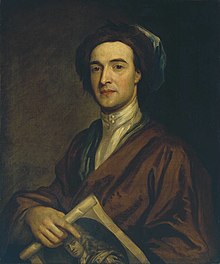
John Smith (c. 1652 – c. 1742) was an English mezzotint engraver and print seller. Closely associated with the portrait painter Godfrey Kneller, Smith was one of leading exponents of the mezzotint medium during the late 17th and early 18th centuries, and was regarded among first English-born artists to receive international recognition, along the younger painter William Hogarth.
Life
Smith was born in Daventry, Northamptonshire, about 1652. He was articled to a painter named Tillet in London, and studied mezzotint engraving under Isaac Beckett and Jan van der Vaart. Smith became the favourite engraver of Sir Godfrey Kneller, whose paintings he extensively reproduced, and in whose house he is said to have lived for some time.
At the end of his career, Smith retired to Northamptonshire, where he died on 17 January 1742 at age 90. He was buried in the churchyard of St Peter's, Northampton church, where there was a tablet to his memory and that of his wife Sarah, who died in 1717.
Works
Smith created approximately 500 plates; nearly 300 of these plates were portraits of notable men and women of the period between the reigns of Charles II and George II. Smith used pictures from artists such as Peter Lely, Godfrey Kneller, Willem Wissing, Michael Dahl, John Riley, John Closterman, Edward Gibson, and Thomas Murray. The rest of Smith's plates have sacred, mythological, and genre subjects after Titian, Correggio, Parmigianino, Carlo Maratti, Godfried Schalcken, Egbert van Heemskerck, Marcellus Laroon and others.
Most of Smith's early plates had been published by the renowned print seller Edward Cooper. In 1700, Smith became a printseller at the Lyon and Crown in Covent Garden and started publishing his own works. Smith also reissued many plates by Beckett, Bernard Lens, Williams, and others, retouching them and erasing the original engravers' names. Smith's latest print appears to have been the portrait of the young Prince William, Duke of Cumberland, after Joseph Highmore, dated 1729.

The bulk of Smith's copperplates eventually came into the hands of publisher John Boydell, who reprinted them in large numbers.
In 1696, Kneller painted a portrait of Smith holding a Kneller engraving and gave it to him. In 1716, Smith created a print from that portrait. Samuel Freeman later engraved that image for Horace Walpole's Anecdotes. Kneller's portrait of Smith is part of the collection of the Tate Gallery, London.
Notes
- See picture at the Tate.
Further reading
- Bénézit, Emmanuel (2006) . Benezit Dictionary of Artists. Vol. 12. Paris: Gründ. pp. 1372. ISBN 2-7000-3082-6 – via the Internet Archive.
- Bryan, Michael (1903–1905). Bryan's Dictionary of Painters and Engravers. Vol. 5. New York: Macmillan. pp. 93–94. OCLC 1041637252 – via the Internet Archive.
- Clayton, Timothy (1997). The English Print, 1688–1802. London, New Haven: Yale University Press. ISBN 0-300-06650-3.
- Davenport, Cyril (1904). Mezzotints. London: Methuen and Co. OCLC 1049687052 – via the Internet Archive.
- Godfrey, Richard T. (1978). Printmaking in Britain: A General History from Its Beginnings to the Present Day. New York: New York University Press. pp. 29–30. ISBN 0-8147-2973-8. OCLC 1151065422 – via the Internet Archive.
- Griffiths, Antony (September 1989). "Early Mezzotint Publishing in England. I: John Smith". Print Quarterly. 6 (3): 243–257. JSTOR 41824523.
- Griffiths, Anthony (1996). Prints and Printmaking: an Introduction to the History and Techniques. Berkeley, Los Angeles: University of California Press. p. 85. ISBN 0-520-20714-9. OCLC 1036831840 – via the Internet Archive.
- Griffiths, Antony (2004). "Smith, John". In Matthew, H. C. G. & Harrison, Brian (eds.). Oxford Dictionary of National Biography. Vol. 51. Oxford, New York: Oxford University Press. pp. 202–203. ISBN 0-19-861401-2. OCLC 1035757378 – via the Internet Archive.
- Hind, Arthur M. (1963). A History of Engraving & Etching from the 15th Century to the Year 1914 (3rd, fully rev. ed.). New York: Dover. OCLC 1035610203 – via the Internet Archive.
- Jeffree, Richard (1996). "Smith, John (i)". In Turner, Jane (ed.). The Dictionary of Art. Vol. 28. New York: Grove's Dictionaries. pp. 881–882. ISBN 1-884446-00-0. OCLC 1033666104 – via the Internet Archive.
- O'Donoghue, Freeman Marius (1898). "Smith, John (1652?-1742)" . In Lee, Sidney (ed.). Dictionary of National Biography. Vol. 53. London: Smith, Elder & Co. p. 78.
- Redgrave, Samuel (1878). A Dictionary of Artists of the English School (2nd ed.). London: George Bell. p. 403. OCLC 1043009709 – via the Internet Archive.
- Salaman, Malcolm C. (1906). The Old Engravers of England in Their Relation to Contemporary Life and Art (1540-1800). London et al.: Cassell and Co. OCLC 1049965266 – via the Internet Archive.
- Salaman, Malcolm C. (1910). Holme, Charles (ed.). Old English Mezzotints. London et al.: The Studio. OCLC 1049974212 – via the Internet Archive.
- Smith, John Chaloner (1878–1884). British Mezzotinto Portraits. London: H. Sotheran. pt. 3, pp. 1131–1241. OCLC 679810041 – via the Internet Archive.
- Vertue, George (1765). Walpole, Horace (ed.). A Catalogue of Engravers. Strawberry Hill: Thomas Kirgate. pp. 116–118. OCLC 1039533429 – via the Internet Archive.
- Vertue, George (1934). "The Note-Books of George Vertue Relating to Artists and Collections in England (III)". The Walpole Society. 22. whole issue. JSTOR i40086509.
- Vollmer, Hans, ed. (1937). "Smith, John". Allgemeines Lexikon der bildenden Künstler (in German). Vol. 31. Leipzig: E. A. Seemann. p. 172.
- Walpole, Horace (1849). Anecdotes of Painting in England. Vol. 3. London: H. G. Bohn. pp. 961–963 – via the Internet Archive.
- Attribution
[REDACTED] This article incorporates text from a publication now in the public domain: "Smith, John (1652?-1742)". Dictionary of National Biography. London: Smith, Elder & Co. 1885–1900.
Categories: